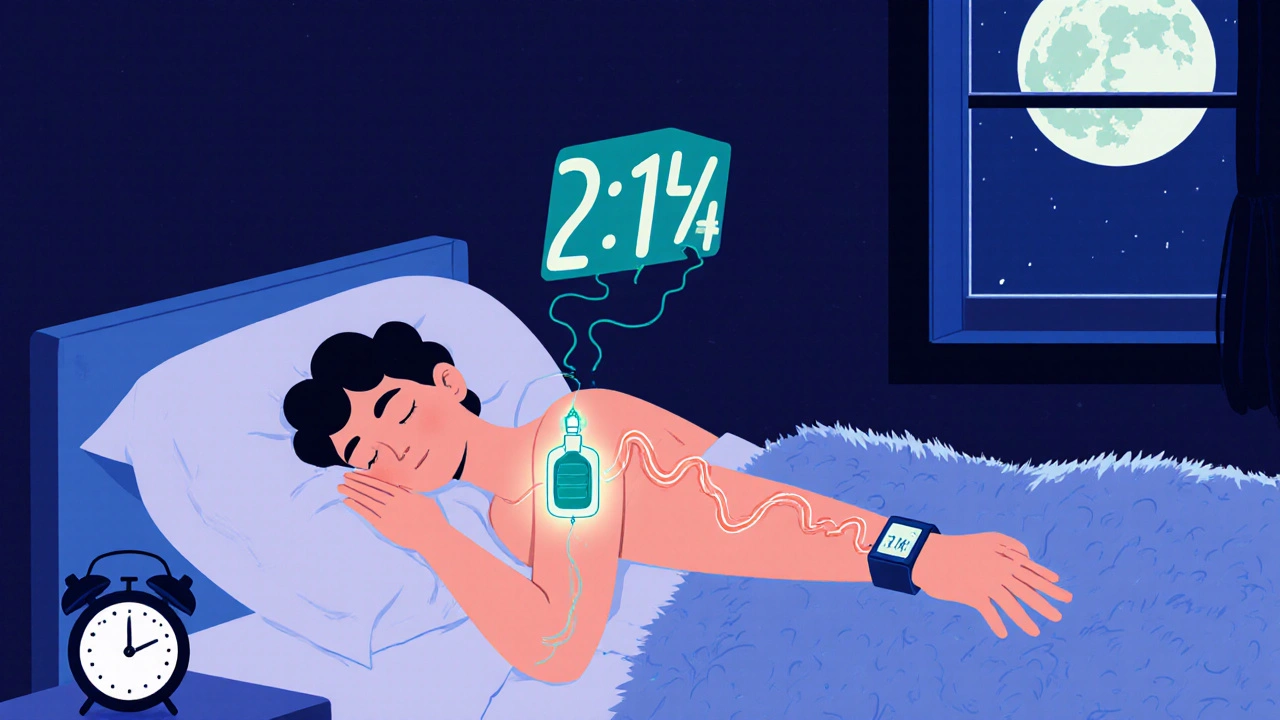What Are Closed-Loop Systems?
A closed-loop system for diabetes is more than just a fancy pump and glucose monitor. It’s a self-adjusting system that acts like an artificial pancreas. When your blood sugar drops or rises, it doesn’t wait for you to notice-it responds automatically. These systems use a continuous glucose monitor (CGM) to track your sugar levels in real time, an insulin pump to deliver the right amount of insulin, and a smart algorithm that connects the two. No manual calculations. No constant finger pricks. Just steady, quiet control.
They’re called hybrid closed-loop systems because they still need you to tell them when you eat. You still have to press a button to say, "I’m having pasta," and enter how many carbs. But once you do, the system takes over. It figures out how much insulin to give, when to give it, and even adjusts overnight based on trends. This isn’t science fiction. It’s what thousands of people with type 1 diabetes are using right now.
How Do They Actually Work?
At the core, every hybrid closed-loop system has three parts: a CGM sensor stuck to your skin, an insulin pump (either worn on your body or as a patch), and a smartphone app that runs the algorithm. The CGM checks your glucose every 5 minutes. That data flows to the pump or app, which then decides whether to deliver more insulin, less insulin, or pause it entirely.
For example, if your glucose is climbing fast after lunch, the system doesn’t wait for it to hit 200 mg/dL. It sees the trend and starts giving small, precise doses of insulin to bring it down before it spikes. At night, if your sugar starts dropping, it slows or stops insulin delivery before you hit danger zone. This is the big shift from older systems. Before, pumps just delivered fixed doses. Now, they react.
Two major systems dominate the market: Tandem’s t:slim X2 with Control-IQ and Insulet’s Omnipod 5. Control-IQ can give automatic correction boluses-meaning if you forget to bolus for a snack and your sugar climbs, it will fix it. Omnipod 5 requires you to announce meals, but its patch design means no tubing. Beta Bionics’ iLet is different: you only input your weight, and it figures out your insulin needs from there. No carb counting, no ratios. It’s the closest thing to a true artificial pancreas available today.
Real Results: What Does the Data Show?
People don’t just say these systems work-they prove it. Clinical trials show users spend 70-75% of their time in the target glucose range (70-180 mg/dL). Before these systems, most people were hovering around 50-60%. That’s a 15% jump in stable blood sugar. HbA1c levels drop by 0.3-0.5%, which sounds small but means fewer long-term complications. Overnight hypoglycemia drops by nearly half. One user on Reddit said, "I haven’t had a severe low in 8 months. Before, it was once a month. I sleep through the night now."
A 2023 study in The Lancet Diabetes & Endocrinology compared hybrid closed-loop users to those on standard pumps. The closed-loop group had 11.2% more time in range. They had 37% fewer low blood sugar events. But there’s a catch: a 1.2x higher rate of diabetic ketoacidosis (DKA). Why? Because if the system fails-say, the pump gets blocked or the sensor stops working-the body can’t get insulin fast enough. That’s why training matters. You need to know the signs of system failure and how to respond.

Who Benefits the Most?
These systems aren’t for everyone, but they’re life-changing for many. Children and teens see the biggest gains. Parents report fewer night-time alarms and less anxiety. Young adults, especially those with busy schedules, say they feel more freedom. One college student told me, "I used to check my sugar before every class. Now, I just go. The system handles it."
People with unpredictable eating habits-shift workers, parents of young kids, or those with eating disorders-have a harder time. The systems still need meal announcements. If you eat at 3 a.m. or snack randomly, the system can’t always keep up. A 2023 JDRF survey found 35% of users with irregular routines stopped using the system within a year.
For those who stick with it, quality of life improves. The Diabetes Technology Questionnaire showed a 22% boost in well-being. People sleep better. They worry less. They stop thinking about diabetes every 15 minutes.
Cost, Setup, and Daily Reality
These systems aren’t cheap. The t:slim X2 pump costs about $6,500 upfront, plus $299 a year for software updates. Omnipod 5 doesn’t have a pump-you buy pods every 3 days at $320 each. That’s roughly $3,800 a year just for pods. Insurance helps, but Medicare only covers 80%. Many people pay thousands out of pocket.
Setting it up takes 3-5 hours. You calibrate the sensor, prime the pump, pair the app, and teach the algorithm how you respond to insulin. Most users need 2-4 weeks to get comfortable. Common problems? Sensor errors (15% of users), poor adhesion (38%), and the system misreading exercise. If you go for a run, your sugar might drop-but the algorithm doesn’t know you’re moving. You have to switch to "exercise mode." Some users use Skin Tac to keep sensors stuck on. Others pre-bolus 15-20 minutes before big meals.
Support varies. Tandem’s customer service answers calls in under 9 minutes on average. Omnipod’s instructions are less clear, according to user reviews. Many rely on online communities like the T1D Exchange Forum or OpenAPS, where thousands share fixes and tips.

What’s Coming Next?
The next big leap is fully closed-loop systems-no meal announcements needed. Beta Bionics’ iLet is already close. Omnipod 5’s "Autonomous" mode is in beta testing as of early 2024. It will adjust insulin without you typing in carbs. That’s huge.
By 2025, we’ll see interoperable systems. You’ll be able to use any CGM with any pump. No more being locked into one brand. And by 2026, next-gen algorithms may factor in stress, sleep, and activity levels-not just glucose. Imagine your system knowing you’re stressed from work and adjusting insulin before your sugar spikes.
But challenges remain. Cybersecurity is a real concern. There were 7 documented cases of device hacking in 2023. Reimbursement is still uneven. And that 1.2x higher DKA risk? It’s not going away until systems get smarter at detecting blockages and failures faster.
Is It Right for You?
If you’re tired of constant finger pricks, if you wake up scared of low blood sugar, if you want to stop thinking about diabetes every hour-then yes, this could change your life. But it’s not magic. It’s technology that still needs you to be involved. You need to understand your body, know how to troubleshoot, and accept that it won’t be perfect.
Ask your diabetes care team if you’re a candidate. Check your insurance. Try a demo. Talk to users on forums. The data is clear: time in range goes up. Hypoglycemia goes down. Stress goes down. For many, it’s the most meaningful advance in diabetes care since insulin analogs.








13 comments
Shawn Sakura
I’ve been on Control-IQ for 11 months and I can’t believe how much better I sleep. No more 3am panic checks. My wife says I snore less now. 😊
Paula Jane Butterfield
As a mom of a 12-year-old with T1D, this tech has saved my sanity. I used to wake up every hour. Now? I actually get 6 hours. And yes, I still have to tell it when she eats pizza, but honestly? Worth it.
Willie Doherty
The Lancet study cited has significant selection bias. The cohort was predominantly white, middle-class, and highly educated. Generalizing these results to broader populations is statistically unsound. Moreover, the DKA risk increase is not adequately contextualized in terms of absolute incidence.
Darragh McNulty
OMG YES. My Omnipod 5 is my new bestie. 🤖❤️ I went from 52% time in range to 78%. I cried the first time I woke up without an alarm. You’re not just managing diabetes-you’re getting your life back.
Cooper Long
The data is compelling but the infrastructure required is not scalable. Most patients lack the technical literacy to troubleshoot sensor errors or calibrate algorithms. This is a luxury solution disguised as innovation
Sheldon Bazinga
so you mean to tell me i have to PAY 6 grand for a fancy pump that still cant read my mind? lol. i just eat less carbs and call it a day. also why are we letting tech companies own our blood sugar? 🤡
Sandi Moon
Let’s not forget the 7 documented cases of device hacking in 2023. We’re now trusting our lives to cloud-connected medical devices with zero standardized encryption protocols. This isn’t progress-it’s a biohack waiting to happen. The FDA is asleep at the wheel.
Kartik Singhal
The real issue? Most of these systems require a smartphone. What about people in rural India with no data plan? Or elders who can’t hold a phone? This isn’t medicine-it’s Silicon Valley’s vanity project. The tech is cool. The equity? Not so much.
Logan Romine
So we’ve traded 20 finger pricks a day for 20 app notifications and a $3800 annual pod bill. Truly revolutionary. Next up: a $10,000 AI therapist that tells you to breathe before you bolus. 🙃
Noah Fitzsimmons
Wait, so you’re telling me you don’t just eat a donut and then manually adjust? That’s it? That’s your whole strategy? You’re just outsourcing your brain to a machine? What happens when the algorithm fails? You gonna cry into your glucagon pen? 😭
Corra Hathaway
I used to hate my body. Now I feel like I’m finally in control. I took my first vacation in 5 years. No panic. No extra insulin vials. Just me, my pod, and the ocean. 🌊❤️
Simone Wood
I tried the Omnipod 5. The app crashed 3x in one day. The sensor peeled off during yoga. I spent more time troubleshooting than living. And don’t get me started on the customer service. They sent me a PDF. A PDF. I’m not a robot.
Swati Jain
The iLet is the future. No carb counting? No ratios? Just weight? That’s how insulin should’ve been designed from day one. Why do we still treat diabetes like it’s 1998? The tech is here. The bureaucracy isn’t.